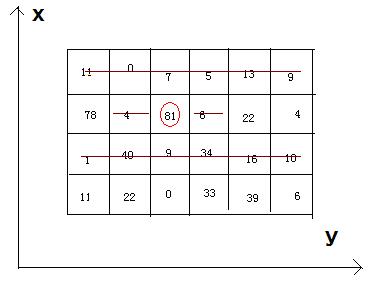nyoj 234 吃土豆
2016-05-13 21:18
363 查看
描述

输入
输出
样例输入
样例输出
思路:
考虑对于某行某列元素,row[i][j]表示加上位置为i,j的土豆的质量的i行j列最大的和
列的最大值:row[i][j]=max(row[i][j-2]+row[i][j-3])+val
看图说话:

假设红色的格子为i行j列,那么它的前面有两种选择方案:
1、选择蓝色格子
2、选择黄色格子
那么该行最大的和是什么呢?
由于n列、n-1列具有状态无关性(n-1列的状态影响不了n列的状态),很显然等于max(row[i]
,row[i][n-1])
同理对于dp[i] (i行的最大值)
dp[i]=max(dp[i-2],dp[i-3])+max_row[i]
看图说话:

max土豆质量=max(dp[m],dp[m-1])
为了方便计算,我的代码把n,m扩大了2
AC代码:
Bean-eating is an interesting game, everyone owns an M*N matrix, which is filled with different qualities beans. Meantime, there is only one bean in any 1*1 grid. Now you want to eat the beans and collect the qualities, but everyone must obey by the following rules: if you eat the bean at the coordinate(x, y), you can’t eat the beans anyway at the coordinates listed (if exiting): (x, y-1), (x, y+1), and the both rows whose abscissas are x-1 and x+1.

Now, how much qualities can you eat and then get ?
输入
There are a few cases. In each case, there are two integer M (row number) and N (column number). The next M lines each contain N integers, representing the qualities of the beans. We can make sure that the quality of bean isn't beyond 1000, and 1<=M,N<=500.
输出
For each case, you just output the MAX qualities you can eat and then get.
样例输入
4 6 11 0 7 5 13 9 78 4 81 6 22 4 1 40 9 34 16 10 11 22 0 33 39 6
样例输出
242
思路:
考虑对于某行某列元素,row[i][j]表示加上位置为i,j的土豆的质量的i行j列最大的和
列的最大值:row[i][j]=max(row[i][j-2]+row[i][j-3])+val
看图说话:

假设红色的格子为i行j列,那么它的前面有两种选择方案:
1、选择蓝色格子
2、选择黄色格子
那么该行最大的和是什么呢?
由于n列、n-1列具有状态无关性(n-1列的状态影响不了n列的状态),很显然等于max(row[i]
,row[i][n-1])
同理对于dp[i] (i行的最大值)
dp[i]=max(dp[i-2],dp[i-3])+max_row[i]
看图说话:

max土豆质量=max(dp[m],dp[m-1])
为了方便计算,我的代码把n,m扩大了2
AC代码:
#include <iostream>
#include <cstdio>
#include <cstring>
using namespace std;
#define N 506
int n,m;
int col
;
int dp
;
int main()
{
while(scanf("%d%d",&n,&m)==2){
memset(col,0,sizeof(col));
memset(dp,0,sizeof(dp));
for(int i=3;i<n+3;i++){
for(int j=3;j<m+3;j++){
int x;
scanf("%d",&x);
col[i][j] = max(col[i][j-2],col[i][j-3])+x;
}
}
for(int i=3;i<n+3;i++){
dp[i]=max(dp[i-2],dp[i-3])+max(col[i][m+1],col[i][m+2]);
}
printf("%d\n",max(dp[n+1],dp[n+2]));
}
return 0;
}
相关文章推荐
- java RMI
- Unity3D研究院之两种方式播放游戏视频
- USACO 最长前缀 Longest Prefix
- 237. Delete Node in a Linked List [easy] (Python)
- C++数组名的理解
- POJ-1094-Sorting It All Out(拓扑排序)
- LintCode 主元素
- 有向图的强连通分量
- 指南针安卓demo
- 如何在程序中使用CString
- java 在线源码网址
- 怪物AI之发现玩家(视觉范围发现系列)
- 上线步骤总结
- 一些关于dagger2的理解
- iOS开发——数据库(FMDB框架的使用)
- 在Centos7上搭建SVN服务器并实现自动同步至web目录
- 交换两个值函数swap()实现小结
- Spring_Spring事务配置的五种方式和spring里面事务的传播属性和事务隔离级别
- dx学习日记
- myeclipse的一个错误
